GREEN Energy from Water
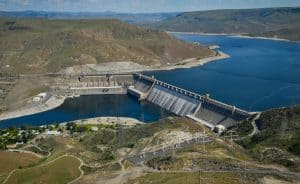
Hydroelectric Power
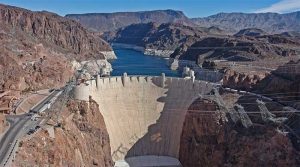
Hydroelectricity is the largest source of renewable energy worldwide for electricity generation, supplying over 1 billion people globally with low-carbon electricity. The prevalence of hydroelectricity, especially hydroelectric dams, is significant in the United States, and worldwide. Hydroelectric dams are the primary source of hydroelectric power worldwide (and dams are also the largest source of clean energy globally).
Hydroelectricity accounts for about 16% of the world's electricity (about 60% of the world's renewable energy is sourced from hydropower). In the United States, about 30% of U.S. renewable energy is from hydroelectricity, and that works out to about 6% of total electricity used in the U.S.
Water is the steadiest and most consistent renewable energy source in the U.S., and worldwide, besides wind. (However, solar is projected to continue growing exponentially and to become the most prevalent renewable energy source in the U.S., and worldwide, by mid-century.)
Hydroelectric dams emit virtually zero greenhouse gas emissions (GHGs) from the actual energy generation process of the dam (although methane is released by stagnant water and ecosystems in a dam's reservoir). The relatively low GHG output from dams makes hydroelectric dams an important source of low emissions, clean energy (relatively clean, compared to fossil fuels).
Before the ongoing, accelerating surge in wind energy (and an emerging ongoing, accelerating surge in solar), hydroelectricity has historically been the world's most important clean energy source.
In fact, presently (and until overtaken by wind energy globally), hydroelectricity is still the world's dominant clean energy source. [Wind energy has overtaken hydro in the U.S., and in many European countries, however, hydro is still relied upon as the dominant clean energy source in many countries throughout the world.]
Hydroelectric dams work by generating energy from reservoirs; the reservoir behind a dam represents potential energy. When operators of a hydroelectric dam need to start generating energy, the water in the reservoir is released, and allowed to flow through the penstock towards the dam's hydroelectric turbines. Water spins turbines, which drive generators to produce electricity.
Electricity can be reliably produced by dams as long as rain and snowfall fill the reservoir. There is a small amount of GHGs produced from the required maintenance of dams, and ecological pollution generated from an operational hydroelectric dam.
In addition to dams, hydrokinetic power systems are promising renewable energy sources. The most commonly used hydrokinetic systems in the world today use tidal power to generate energy. Hydrokinetic power sources include tidal barrages, tidal stream generators, and wave farms (which are currently in research and development). [See descriptions of hydrokinetic systems below]
Here is a simple diagram illustrating how a hydroelectric dam works-
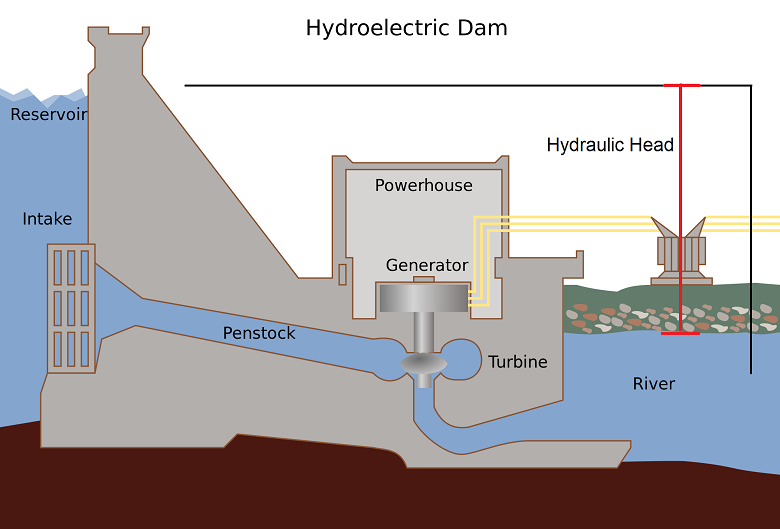
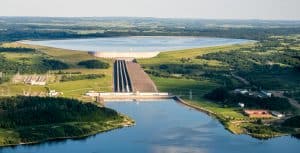
A great feature of hydroelectric production is that energy can be stored easily. If more water is flowing over a dam than electricity demands are at the time, the excess generated electricity can be used to pump water back into the reservoir so it can flow down again later.
Some energy is lost in the process, but this ability to store energy using the original design of the plant is unique to hydropower – coal and gas-burning plants can’t store energy in a similar way. This technology is called 'pumped hydro energy storage'.
All that is needed for pumped hydro is the upper reservoir of the hydroelectric dam, and either an existing lower reservoir at the bottom of a hill or the topography to create the lower reservoir. Then, the pump system can be installed to carry water up to the reservoir behind the dam.
Electricity produced from hydroelectric plants is cheap and fairly clean. After all, the fuel – flowing water – is free and there are no emissions from the electricity generation process. The turbine generators are relatively simple and low maintenance. Once the dam is built, operational costs and maintenance costs for hydroelectric dams are low.
The fuel for hydroelectric dams is water - free, abundant, renewable, and the hydroelectric generation process itself is completely environmentally friendly, creating no pollution and no greenhouse gases. The environmental problems with dams stem from the reservoirs and the water released downstream as dams are operated.
Unfortunately, the stagnant water in a dammed reservoir does create hazards to local ecosystems. The water released through dams harms aquatic animals, plant life, and wildlife in downstream rivers. Dams cause erosion, algal blooms, and degrade river water and ecosystems downstream. At times, a hydroelectric dam can generate GHGs from the decomposing plant life and cause ecological damage in its reservoir. However, at other times, the dam acts as a carbon sink, sequestering GHGs.
Most hydroelectric dams are large; for example, the Hoover Dam on the Colorado River in Nevada/ Arizona. The Hover Dam can produce over 2GW of energy and when run at its full production capacity, the Hoover Dam can supply enough power for 1.3 million homes in the Nevada/ Arizona area where it operates (and even provides energy to homes in California).
However, smaller-sized dams also produce clean energy from a renewable resource, like a small river. By the very nature of their small size, small dams avoid the number and amount of environmental issues (water stagnation, erosion, algal blooms, etc...) of larger projects.
Hydrokinetic Systems
Other forms of hydroelectricity include hydrokinetic systems for harvesting energy from tides and currents (tidal barrages, tidal stream generators), energy from ocean waves, and even the use of hydroelectric water mills in creeks.
Even though water mills are mostly historical artifacts, which are restored to maintain function in the United States and other 1st-world countries, upgraded water mills are still useful (for jobs like rice harvesting, etc...) in places like Nepal, India, and China. Watermills are still one of the original zero-carbon sources of energy, fighting climate change before that was even a term for the consequences of man-made pollution (also, before man-made climate change was even an issue).
One hydrokinetic energy generation system used throughout the world today is the tidal barrage system. A tidal barrage is, in essence, a dam before an estuary, lagoon, river, bay, small lake, or other body of water.
At high tide, water is trapped behind the barrage and gradually released through turbines, generating power in much the way a hydroelectric dam on a river would. Slices in the tidal barrage system in the rivers leading to the estuary let water through as the tide goes from high to low, and turbines in the barrage's slices generate electricity.
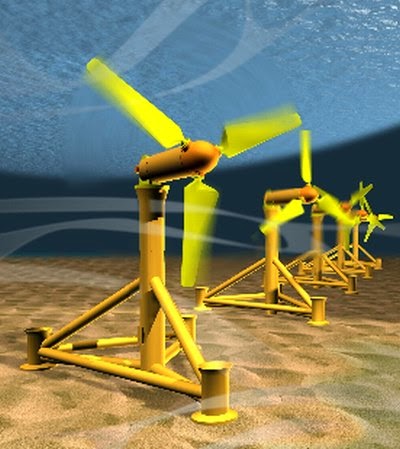
Tidal stream generators are also used in run-of-river and estuary applications, and used both in freshwater and salt/freshwater mixed bodies of water. Tidal stream generators operate in the flow of tides.
In many ways, they are like underwater wind turbines, with the flow of water caused by tides or currents turning the turbines. Engineers are exploring many possibilities of tidal stream generators in the hopes of finding the most reliable, efficient, and affordable system.
In addition to tidal hydropower systems, there are a variety of ways to harvest ocean wave energy to create renewable energy. More than 50% of the American population lives within 50 miles of coasts, which is significant because ocean renewable energy technologies are in the research and development stage in the United States, as well as throughout the world.
Off the coasts of France, Portugal, Ireland, and the UK, among other countries, and in the state of Hawaii, there are a few demonstration projects for R&D on harnessing the energy of the ocean.
For more on this topic, please see: Marine and Hydrokinetic Power
Please see: Renewable Energy Overview
Please also see: Hydropower in the USA